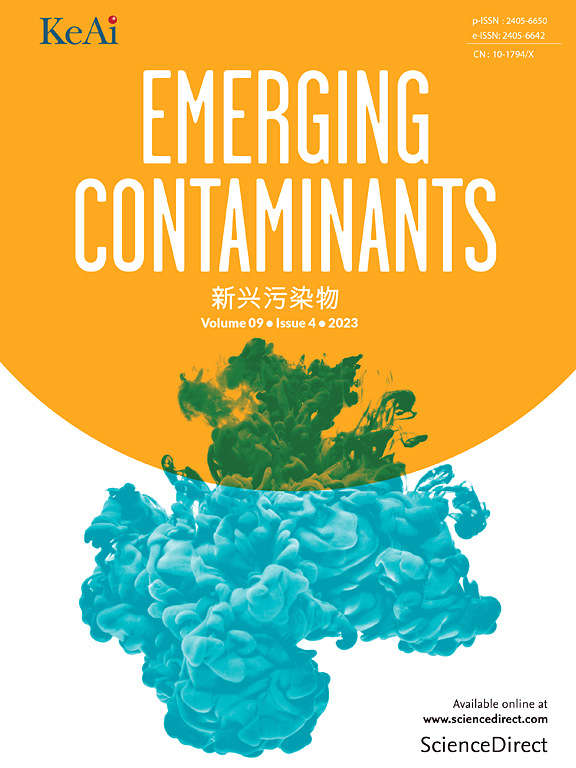评价乙硫普罗的对映选择行为:对水生系统健康和人类安全的影响
IF 6.9
2区 环境科学与生态学
Q1 ENVIRONMENTAL SCIENCES
引用次数: 0
摘要
越来越多的手性杀虫剂被释放到水生环境中,对环境造成了不利影响。此外,这些杀虫剂对环境、人类和其他非目标物种有潜在的不良副作用,可能破坏整个生态系统。本研究探讨了乙硫普罗对映体对沉积物、浮萍和人体细胞中微生物的作用。结果表明,s -乙虫腈在沉积物中具有优先降解作用,具有对映选择性。在高浓度(33:25 = r -乙硫丙烯:s -乙硫丙烯)处理下,浮藻过氧化氢酶和超氧化物歧化酶活性显著受到抑制,浮藻叶数明显减少。此外,r -乙硫普罗(0.42 mg/g)处理组叶绿素b含量比s -乙硫普罗(0.20 mg/g)处理组降低近2倍。细胞毒性试验显示,s -乙替普罗的毒性分别是rac-和r -乙替普罗的2倍和3倍。在对映体处理的人细胞中,CAT、SOD和caspase-3的表达上调,表明氧化应激是毒性的关键因素。总的来说,s -乙普罗在人体细胞中表现出比rac-和r -对映体更大的副作用。这些发现表明了手性在水生环境有害化学物质风险评估中的重要性。本文章由计算机程序翻译,如有差异,请以英文原文为准。

Evaluate the enantioselective behavior of ethiprole: Implications for aquatic systems health and human safety
Increasing numbers of chiral insecticides have been released into aquatic environments, leading to adverse effects on the environment. Furthermore, these insecticides have potentially undesirable side effects on the environment, humans and other non-target species, potentially disrupting entire ecosystems. This study investigated the effects of ethiprole enantiomers against microorganisms in sediment, duckweed, and human cells. The results showed that S-ethiprole degraded preferentially in sediment, demonstrating enantioselective behavior. In sediment, catalase and superoxide dismutase activities were significantly inhibited, and the frond number of duckweed preferably decreased with exposure to S-ethiprole at high concentration treatments (33 : 25 = R-ethiprole: S-ethiprole). Additionally, the content of chlorophyll b decreased nearly 2 times in R-ethiprole (0.42 mg/g) treatment group in comparison to S-ethiprole (0.20 mg/g) treatment. Cytotoxicity test revealed that S-ethiprole was 2 and 3 times more toxic than rac- and R-ethiprole. The expressions of CAT, SOD and caspase-3 were up-regulated in human cells treated with ethiprole enantiomers, indicating oxidative stress as a key factor in toxicity. Overall, S-ethiprole exhibited greater adverse effects than rac- and R-enantiomers in human cells. These findings demonstrate the importance of considering chirality in the risk assessment of harmful chemicals in the aquatic environment.
求助全文
通过发布文献求助,成功后即可免费获取论文全文。
去求助
来源期刊

Emerging Contaminants
Medicine-Public Health, Environmental and Occupational Health
CiteScore
10.00
自引率
6.70%
发文量
35
审稿时长
44 days
期刊介绍:
Emerging Contaminants is an outlet for world-leading research addressing problems associated with environmental contamination caused by emerging contaminants and their solutions. Emerging contaminants are defined as chemicals that are not currently (or have been only recently) regulated and about which there exist concerns regarding their impact on human or ecological health. Examples of emerging contaminants include disinfection by-products, pharmaceutical and personal care products, persistent organic chemicals, and mercury etc. as well as their degradation products. We encourage papers addressing science that facilitates greater understanding of the nature, extent, and impacts of the presence of emerging contaminants in the environment; technology that exploits original principles to reduce and control their environmental presence; as well as the development, implementation and efficacy of national and international policies to protect human health and the environment from emerging contaminants.
 求助内容:
求助内容: 应助结果提醒方式:
应助结果提醒方式:


